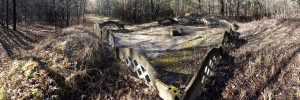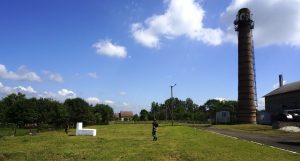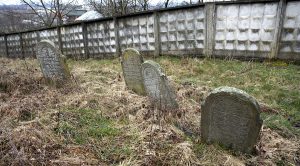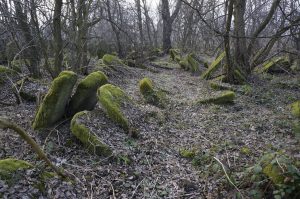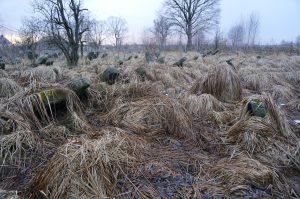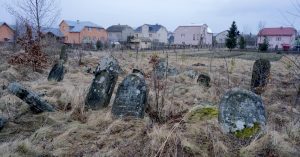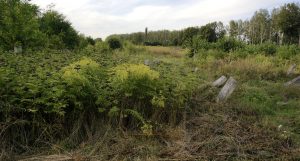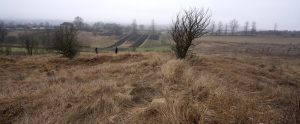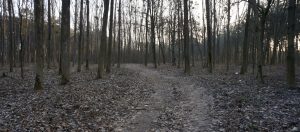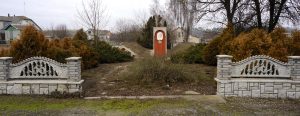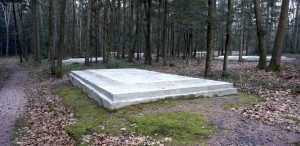![]() Ця сторінка також доступна українською.
Ця сторінка також доступна українською.
Introduction
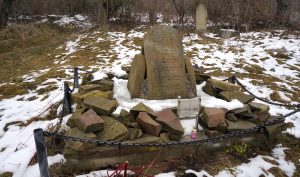
Collected headstone fragments at the new Jewish cemetery in Chortkiv (Ternopil oblast). Photo © RJH.
In our meetings with three professors of architecture at the Lviv Polytechnic University in 2019, intended to open a dialogue to help us learn best practices for stone conservation plus landscape and memorial design, each of the three experts made a point to emphasize the primary importance of developing one or more overall concepts early in any new heritage project plan, regardless of the intended project size. A clearly-articulated concept enables project leaders to consider and communicate intent, efficiently and effectively marshal resources, detail and review designs, and select and apply information, methods, tools, and materials. Concepts (and their frequent review) provide a guide rail for managing the complexity of cemetery preservation projects and adapting to the inevitable unexpected issues. Well-defined concepts distill and clarify the essential components of project designs, and the ways those components work together. The process of developing a project’s concept promotes awareness of the motivations which drive project activists, and creates opportunities to consider other alternatives which may better serve the ultimate goals more sustainably.
Few of the example projects summarized in the case studies section of this website explicitly include a discussion of the original project concepts, although those ideas are often evident in realized project features and sometimes implicitly defined in the discussions of project details and issues encountered. For some burial site projects with recurring activity spanning years, such as clearing wild vegetation, it is normal for concepts to evolve over time as physical and intangible project landscapes change.
The breadth of topics which may inform cemetery project concepts is far too large for any practical project activist to fully study and consider. A selection of print and web resources with potential relevance to concepts for burial site preservation and commemoration in western Ukraine are listed and linked on a references page on this website; however, the information resources for other project phases may also be useful in developing and evaluating concepts. The project examples discussed and illustrated on all of the pages of this website (including in this guide section, the case studies, the burial sites listings, and more) may be the best resource to stimulate ideas for new plans and designs, and to encourage the first steps in developing concepts.
Note that much of the conceptual literature on heritage does not specifically address Jewish burial sites in Europe, but still applies very well to the concerns of project leaders and volunteers for many typical projects to be conducted in western Ukraine. Usually, however, the unique culture and history of Jewish communities in the region before and during World War II must also be considered as part of overall concepts to create and manage projects at shared heritage sites in contemporary Ukraine.
Elements of a Project Concept
A sample list of possible elements of a heritage project concept are listed below, for consideration during the development of a concept for a specific Jewish burial site. These elements are all recommended, but some may not be applicable to certain sites or project types. Definition of the elements in a documented concept may be broad and high-level or specific and detailed, depending on the maturity of the overall project plan:
- a clear statement of essential themes and goals, both tangible and intangible
- identification of site ownership and stakeholders
- identification of the “audience” for the project
- explanation of the use of symbolism, materials, colors, and textures to communicate themes
- a strategy for addressing the relationship between the site and the Holocaust
- phasing of the project (in steps over time), if appropriate or necessary
- identification of resources for design, labor, materials
- a plan for engaging the local community in development and sustaining
- a cost estimate and a plan for funding the work plus ongoing maintenance
- a strategy for communication both about the project and about the heritage, at the site and in wider spheres (including websites and social media)

The erased Jewish cemetery of Hrymailiv (Ternopil oblast), site of an unmarked mass grave. Photo © RJH.
Public documentation of project concepts for Jewish cemetery projects in western Ukraine is rare, even after a project is completed (let alone before). Browsing the case studies on this website shows very few with project concepts on the activists’ websites or in other public media, except for the projects which only survey and document cemeteries; exceptions include a perimeter fencing project and a multi-facet rehabilitation project. However, useful methods for documenting and communicating a project concept in text and images can be found in the fields of building and landscape architecture; resources relevant to cemeteries can be found on this website among the references for landscape planning, development, and care.
This page does not discuss each of the suggested concept components in detail; instead we outline below several of the key questions and issues which can drive project concepts. Many other issues appear on other guide pages, from preliminary assessment through practical construction phases to communication. Project concepts should be informed by ideas from other phases of project development, especially those which impact the feasibility of achieving the project and the long-term sustainability of the results. Even projects which already have concepts in development or review may benefit from considering some or all of these topics.
A Kind of Self-Evaluation: What Do You See?
This website and its components do not address the motivations which drive people to create and develop projects at Jewish burial sites in western Ukraine, but rather the mechanics of acting on those motivations. However, we recognize that emotions can run strong before, during, and after projects are planned and implemented, and that people take very personally their connection to these places. Before working to develop a project concept, it may be useful to pause and reflect on the presentiments which you bring to the project, your emotional response to visiting the site (or seeing it in photos and video), and your resulting motivations; these all influence the goals which you set for the project, and it is good to be aware of your psychic state as you assemble the practical elements of a project.
The photograph at the top of this page (shown again at right here – click on the image to enlarge it) shows a portion of the Jewish cemetery in Rozhniativ, a small town in the Ivano-Frankivsk oblast of western Ukraine, as the cemetery appeared in early 2020. If you do not already have experience with the current state of Jewish burial sites in the region, it may be helpful to ask yourself what you see when you study this photo, and what feelings and impulses the image arouses in you, and then compare your reactions to those of other people. A wide variety of responses (sadness, shock, nostalgia, anger, and even romance because of the visual appeal of ruins) are possible, none of them “wrong” – considering the possible perspectives can aid the development of concepts for addressing a site like the Rozhniativ cemetery with some form of “preservation” project.
Context is critical; an understanding of the historical and cultural forces which created, shaped, and transformed this site from its establishment to its current state is important to the success of a project over the long term, including its reception within the current local Ukrainian (non-Jewish) community and with both physical and virtual visitors to the site, including foreign Jewish descendants. Even without any “intervention”, a burial place has many concurrent layers of historical and contemporary meaning: as a gathering of centuries of ancestors in a “house of life” and memory, as evidence and symbol of Holocaust desecration and destruction, as an open-air museum of art and poetry, as parkland or a wild space for quiet recreation, as a path from home to work, and more.
No one is completely fluent in the full range of Jewish burial site conditions and challenges in western Ukraine; exposure and experience helps all of us develop appreciation and realistic ideas for ways to help. If you have not already visited several cemeteries and mass graves in the region, a thoughtful essay written and illustrated by Christian Herrmann during his own extensive travels visiting Jewish heritage throughout eastern Galicia and northern Bukovina in 2013 gives an excellent introduction to the region’s multicultural past, the condition of Jewish burial sites in today’s western Ukraine, some causes of that condition, and importantly, ways of thinking about the heritage embodied in these places. Christian is neither Jewish nor Ukrainian, but has a perceptive eye and a reflective mind which helps others to see and appreciate what they may otherwise overlook. We have followed his journeys on his blog site Vanished World for years, and traveled with him extensively in western Ukraine and beyond; you will see him at work and examples of his research, photography, and writing on many pages of this website, as he has been a valuable resource for our own project thinking.
Another excellent introduction to the history and recent status of Jewish burial sites in Ukraine, with a special focus on ways that western Ukraine differs from the rest of the country, is given in the 78-page collection of introductory essays in the 2005 report by the US Commission for the Preservation of America’s Heritage Abroad on Jewish Cemeteries, Synagogues, and Mass Grave Sites in Ukraine, under the research direction of Samuel Gruber. Though now more than 15 years old and covering a country which is changing rapidly since its independence in 1991, the report and its essays still well address the historical, social, religious, and economic factors which have influenced the current state of Ukraine’s Jewish cemeteries and mass graves, as well as the opportunities and impediments to visiting and working at these sites. The essays are illustrated with a selection of site photographs taken between 1995 and 2000, including more than a third from western Ukraine, providing literal snapshots in time of many sites – a useful reference for measuring both progress and loss in the subsequent years.
Many more photographs from recent years of Jewish burial sites in western Ukraine are included on every page of this website; the images include “natural” sites (without any postwar preservation projects), completed projects, projects in progress, and sites where projects have been started or completed in the past but are now in decay. Studying these examples can provide both context and understanding that most Jewish cemeteries and mass graves in the region share characteristics, opportunities, and challenges with many other sites.
The Breadth of Responses to Heritage in Apparent Need
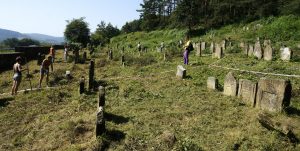
Vegetation clearing during a volunteer event organized by the LVC at the Jewish cemetery of Staryi Sambir (Lviv oblast). Photo © RJH.
Acting on the motivations to do something to slow, halt, or reverse visible damage or deterioration at Jewish burial sites can take many material forms on a spectrum ranging from near restoration to managed decay, as well as an even greater variety of intangible forms. The language of cultural heritage is rich, but many people, including both trained and untrained activists, use the terminology loosely: terms such as restoration, rehabilitation, preservation, and conservation have overlapping meanings which differ in different contexts. Many of the books and essays listed among references for project concepts on this website can help set a framework for thinking and communicating about ideas as they develop.
Some of those same references also raise a perhaps counterintuitive question: is it always necessary or even appropriate to respond to heritage in decline with a physical project of “preservation” (or any of the other terms)? Asked another way, when are the best responses limited to surveys, documentation, signage, and education?
Reflecting on these “limit” questions may allow consideration of a broader range of possible approaches to Jewish burial sites in western Ukraine, including some which could be more compatible with the region’s economy, social environment, and climate, leading to results which may be more sustainable and effective toward the project goals.
One such approach is manifest in the design philosophy and realized projects of Georges Descombes, a Swiss landscape architect whose work is analyzed in books and essays by Marc Treib (see the references list for several examples). The methods and results of Descombes could be described as minimalist; the title of one of Treib’s books is Doing Almost Nothing (ORO Editions, 2019, quoted below), after a remark in an unfavorable project review by another critic. However, as Treib explains, Descombes works more in the manner of a forensic scientist, examining the evidence of what had once characterized the site, as well as the evidence of what remains. From these meticulous investigations his ideas take direction and shape, responses derived from the history of the site, its natural or architectural context, and the contemporary social, political, and economic pressures that always influence the course of design. (p.16) [H]is working method focuses neither on a constructed product alone, nor accepts the site exactly as it is, nor attempts to restore the site to a once-existing condition. (p.14) Importantly, his project designs render the existing conditions more apparent; abstain from adding any elements unneeded, or conditions extraneous to the site; reveal all that had been the [natural] landscape and its human additions, both those natural and those constructed. (p.14) His work tends to be psychological and perceptual as well as physical and haptic. (p.17)
Another approach relevant to certain sites is defined and tested in Caitlin DeSilvey’s Curated Decay: Heritage Beyond Saving (University of Minnesota Press, 2017) and other writings and video; see the references page for concepts. As a heritage academic and practitioner with experience at historic and modern sites which exhibit challenges in the conservation of architectural features, landscapes, and small cultural artifacts, DeSilvey proposes considering collaboration with the natural processes of decay rather than attempts to oppose or reverse them. The theme of curation runs through her thesis: selecting, organizing, and guiding, retaining and promoting cultural memory even as physical objects diminish.
It is important to highlight that neither of these approaches is passive (or lazy, reticent, fatalist, or defeatist); both are studied and active in their management of sites, without monumentality or large gestures. Each may provide a useful perspective to one or more aspects of a project concept in development.
Shared Heritage: Owners and Stakeholders, Activists and Neighbors
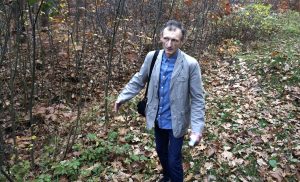
A local historian relates the events leading to a mass grave in the forest near Sivka-Kaluska (Ivano-Frankivsk oblast). Photo © RJH.
We discuss shared heritage here because Jewish burial sites in western Ukraine do not “belong” exclusively to any one group, local or foreign, civil or religious; with a careful approach and a reasonable group of activists, this fact can help to sustain and preserve cemeteries and mass graves as well as the memory of the communities which are buried there.
In the guide page covering site surveys on this website, the section on the modern civil/legal status of Jewish burial sites discusses different types of possible owners and stakeholders, and how those interested parties may be identified and engaged; another section of the same page highlights neighboring residents and businesses as additional parties who can affect and are affected by nearby Jewish burial sites, project work, and visitors. It is important for Jewish descendants and activists, who may have an emotional stake in a burial site, to recognize that local Ukrainian people also derive part of their identity from these places and the history which is tied to them. It is important for Ukrainian residents, who have a fundamental interest in the present and future of their towns where Jewish burial sites are present, to recognize that visiting Jews may have generations of family members buried at these sites, and the same kind of deep tie to this land as members of other faiths and ethnicities have to their own. There is room at these sites for both, and for a shared appreciation of a site’s intertwined history.
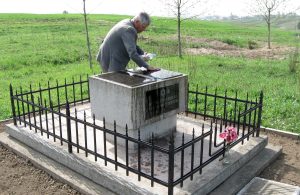
A retired local school teacher cleans a Jewish mass grave memorial in Rohatyn (Ivano-Frankivsk oblast). Photo © RJH.
A complex and often fluid question is: who should take responsibility for these heritage sites? The answer varies, but rarely points to local government administrations or to local Jewish communities; the economy in today’s western Ukraine is too small to support much cemetery care (even for the majority religious and ethnic group), and of the few regional Jewish communities, none has membership large or vital enough to raise funds for more than sustaining small charitable actions. So the question which should probably be asked instead is: who can take responsibility for these heritage sites?
One possible answer is provided by the regional World War I soldiers’ cemeteries of foreign armies, e.g. the numerous Ottoman and Austro-Hungarian imperial military cemeteries now maintained with funding and support from the Turkish and Austrian governments and assigned NGOs, in cooperation with local civic authorities in the areas where the cemeteries were established during the war. There are difficulties adapting this model for Jewish cemeteries, in part because no single foreign country accepts a similar responsibility and clearly because of the sheer number of sites. Germany has accepted significant responsibility for cemeteries which were damaged and mass graves which were created during its occupation of central and eastern Europe, and provides support for site rehabilitation under several official programs running for years; see the guide page on support and fundraising for more information. Despite the imperfect fit of the WWI cemeteries model, it still indicates that there are ways to assemble foreign-local cooperation for responsibility and long-term care of Jewish burial sites.
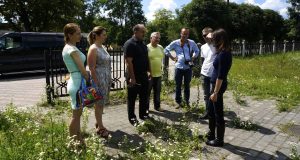
City officials of Zolochiv (Lviv oblast) discuss concerns about care of the Jewish cemetery with visiting heritage activists. Photo © RJH.
A review of successful and unsuccessful heritage projects in western Ukraine makes clear that any concept and plan for cemetery preservation depends on collaboration between Jewish and Ukrainian people in a variety of roles. Heritage means inheritance, and for these sites there are multiple inheritors; responsibility is tied not so much to ownership as custodianship: who can and will care for the place, in what ways. In The Production of Heritage: The Politicisation of Architectural Conservation (Routledge, 2020), the authors Alan Chandler and Michela Pace highlight how the interrelated stories these different communities tell themselves about a place can lead to mutually beneficial results: The narratives that historic fabric contains can help shape the meaningful involvement of local people, providing a roadmap for those navigating the double-bind of using the past to underpin the future. (p.iii) [H]eritage custodians are increasingly reliant on voluntary or community support to sustain themselves and their ‘assets’. (p.ix)
Consideration of the shared aspect of the heritage necessarily extends to all aspects of a project concept, and beyond to the plans and physical work as well as all forms of communication about the project. To take a simple but important example, site labor schedules need to allow for religious holidays of both Jewish and regional Christian faiths, which means abstaining from site work not only on Saturdays and Sundays but also on the major holidays and great feasts of each of the faiths – sometimes significantly interrupting work in key spring, summer, and autumn months.
How Should We “Use” a Jewish Cemetery in Western Ukraine?

Local civil and religious leaders discuss options for rehabilitation of the old Jewish cemetery of Rohatyn (Ivano-Frankivsk oblast). Photo © RJH.
Almost none of the Jewish cemeteries in western Ukraine are in active use for current burials, many are not now recognizable even as cemeteries, and a majority of Jewish mass graves in the region have unknown boundaries, without signs or memorial markers. While most Ukrainian and foreign Jews recognize all of these burial sites as holy ground in Jewish tradition, there is less agreement about how to approach and use these sites for memorialization, both religious and social. It is understandable that many people, both Jewish and non-Jewish, consider these places from their personal cultural upbringing and religious training. Unfortunately there are wide differences in those traditions and in interpretation of unwritten “laws”, even within the global Jewish community, and conflicts about and even at burial sites can happen. Fortunately, most people recognize the primary authority of local Rabbinical leaders, who have deeper knowledge not only of the spirit of religious law but also its effective application in modern western Ukraine.
Typically, it is possible to both preserve and adapt a Jewish cemetery for multiple beneficial purposes, including:
- personal prayer
- contemplation
- public history and memory
- honoring tsadikim and placing kvitelach
- personal and community identity development
- cultural education on Jewish perspectives and traditions of death, mourning, and remembrance
- heritage tourism
A few or several of these opportunities are visible in many of the completed projects depicted on this website, not only in the case studies section but also on other pages, including this one.
Highlighting just one of many possible ways that Jews and the local civic or religious community can collaborate to preserve a cemetery and amplify its use as a cultural and educational resource, a posting by the administrator of the private JHE – The Jewish Heritage Europe Group on Facebook mentions three Jewish cemeteries in Europe now serving also as museums:
-

Views of the Jewish cemetery and museum of Wrocław. Photos © Muzeum Miejskie Wrocławia.
The Old Jewish Cemetery of Wrocław (Poland) is administered as a municipal Museum of Cemetery Art, providing funding and staff for preservation as well as historical research, education, and guided tours – which puts the cemetery on cultural tourism tracks and websites for visitors from all over.
- Similarly, the Old Jewish Cemetery of Prague (Czech Republic) is managed by the multi-site Jewish Museum in Prague, a partnership between the city and country’s Jewish communities plus the Prague city administration and tourism offices, the Czech Ministry of Culture, and several national and international Jewish and other organizations, enabling access to the cemetery for study and contemplation as well as long-term conservation of the site and its dense collection of graves and markers.
-
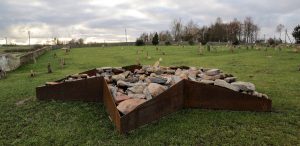
The lapidarium in the cemetery of Šeduva. Photo © A. Baltėnas for The Lost Shtetl.
The Lost Shtetl project of Jewish culture and heritage likewise manages the Jewish Cemetery of Šeduva (Lithuania) with plans for a museum commemorating the lost Jewish community of the town to be housed across the road from the cemetery as part of a larger memorial complex. Complementing the museum exhibition is a database of gravestone epitaphs from the cemetery and a range of other memorial projects. The project is conducted by the Lithuanian NGO Šeduva Jewish Memorial Fund in collaboration with historians and heritage conservation professionals.
Unique opportunities for engaging local and foreign interests (both Jewish and non-Jewish) to help care for a Jewish burial site, and transform it into a welcoming place of mutual respect, may exist anywhere cemeteries and mass graves are found in the once-multicultural region of western Ukraine. The benefits and constraints of such collaborative heritage projects should be considered as a potential bridge to sustainable care in any new project concept development.
The Long Shadow of the Holocaust
Every proposed project at a Jewish burial site in western Ukraine must consider whether and how to acknowledge and reflect the impact of the Holocaust on the site itself and on the former Jewish community which the site represents. At mass graves, the Holocaust is explicit and fundamental in the origin of the site. At cemeteries, at least those which do not also contain mass graves within their boundaries, most or all of the buried dead were not themselves affected by the Holocaust but in some ways they also personify the family and community members who were murdered elsewhere during the war and are lost to oblivion.
The Holocaust has been extensively documented and studied, and remains an important topic of ongoing research and publication in both academic and popular literature and other media. Burial sites are perhaps not ideal places for exposition and education about the Holocaust, but many project activists understandably seek ways to represent the crimes in the symbolism and the brief texts incorporated into memorial monuments, signage, and even landscaping. The modes in which these permanent reminders of terror are portrayed at a cemetery or mass grave will affect site visitors, neighbors, and passersby – some of whom may have conflicting knowledge and understanding of the wartime history.
The references page of this website on project concepts includes a number of works useful to shaping ideas about public memory, the rhetoric of memorials, heritage and identity, sorrow and solace, landscapes of emotion, and landscapes of contemplation; more titles on some of these topics are included in the references page on landscape planning, along with web galleries of realized memorial gardens and cemeteries. The special concern of the Holocaust is evaluated in studies which consider that event alongside other examples of mass trauma in a number of listed essays and books on this site; the language of their titles highlights the complexity of the topic and its opportunities for expression: places of pain and shame; difficult history; difficult heritage; conflicted memory; contested/contesting memories; dark places; between memory and history.
Project Costs, Sustainability and the Future
It can be very difficult to estimate the costs associated with heritage projects, especially those which require design and fabrication of elements outside the activists’ areas of expertise, and at distant places, and in foreign languages. Completed projects, even those with a public presence on the internet, rarely document costs in sufficient detail for later projects to learn from, which diminishes opportunities to promote competition and lower costs. Where available, cost information is included on this website in the case studies section for some of those example projects.
There are few other projects which publicly detail their one-time and/or annual costs; typically these projects are conducted by regional or municipal governments or NGOs, outside of western Ukraine. One recent example is the 2019 annual report published by TAMUS, the Tachov Archives and Museum Society, an NGO organized in the Pilsen region of the Czech Republic but with Jewish cemetery projects all over the country. The report details project work conducted during 2019 and plans for 2020, depicts examples of the past projects, summarizes project and operating expenses (as an archive and museum NGO, research represents 10 times the cost of cemetery restoration), and at the end of the document includes a helpful reference from their experience of the typical costs of documenting, resetting, and re-lettering individual gravestones. See the references page on project support and funding to aid searches for additional comparative cost estimations, especially as reported in the news section of the web portal Jewish Heritage Europe.
Realistic project cost estimates are emphasized here because many cemetery and mass grave projects never get beyond the “dream” phase, due to under- or over-estimation of costs, including volunteer and contractor time for management and site labor.
Sustainability planning is emphasized throughout this website, and it is at no time no more important than in the project concept phase. Examples of one-off projects which rapidly deteriorated due to a lack of ongoing maintenance and support are included in the case studies, and even for burial sites with ongoing monitoring and intervention, ordinary wear and weathering gradually decay both natural and manmade features, including trees and hedges, headstones and grave covers, fences and retaining walls, ground cover plants, gates, signs, monuments, and ohels. After working hard to raise funds for significant project installations, few project leaders also establish funds for ongoing conservation in perpetuity. In this regard, Jewish burial sites in western Ukraine are no different than cemeteries all over the world, with similarly predictable effects, again highlighting the importance of long-term collaboration in project concepts and planning.

